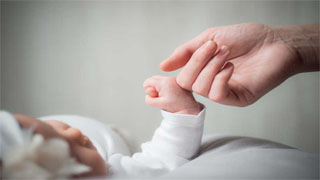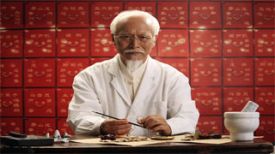
Article excerpt: "Traditional Chinese Medicine Ancient Methods for Infant and Child Health Preservation"
Cerebral palsy is a motor and even language dysfunction caused by the central nervous system. The focus is on motor function. The typical manifestation is to lie down more and move less, often lying down but moving less. In addition, the tension of the muscles in the limbs increases. The so-called muscle tension increases, which means that the muscles are particularly tight, and there will be less casual exercise. Sometimes it is a slow and spasmodic movement. Further down, there is an overactive tendon reflex, and with a gentle touch, it reacts violently.
These nerves have particularly high tension, causing these muscles to remain in a state of spasms and tightness for a long time, unable to relax.
Once the muscles become tense, it will affect his ability to walk. Only by alternately stretching and tightening both legs can one move forward. If one is constantly tense, their walking gait will not be normal. It's called the scissor step, which is a way of walking with two legs bent, split to both sides, or even half squatting. Walking like an elderly person, it requires support, and some children with cerebral palsy may not be able to walk normally or may need to support the handrail next to them to walk. In addition, the movements are very uncoordinated because the muscles are always in a tense state.
Some children with cerebral palsy are accompanied by intellectual disability and language impairment, while others have excellent intelligence but have problems with the peripheral nerves of their muscles and limbs. Some children even have epilepsy, hearing and sensory impairments, learning difficulties, and so on.
Causes of cerebral palsy
1. Abnormalities in the placenta, malposition of the fetus, uterine dysfunction, premature birth, and multiple pregnancies are all pre birth issues. It appeared during pregnancy.
2. Suffocation at birth and lack of oxygen in the brain are the causes of cerebral palsy. Ischemic and hypoxic encephalopathy in newborns can also easily lead to cerebral palsy.
3. Infection and trauma, brain deformities.
Four types
1. Hypoxia asphyxia type: Hypoxia asphyxia type includes fetal hypoxia asphyxia in the mother's uterus, which is more common in cases where the umbilical cord is wrapped around the neck or the fetal position is not correct, which can easily cause fetal asphyxia internally.
During childbirth, neonatal distress asphyxia, respiratory distress syndrome, circulatory failure, and polycythemia can all easily cause brain damage, leading to cerebral palsy.
3. Incorrect fetal position and forceps injury. The fetal position is not correct. The normal fetal position is head to pelvis, but some children may not be head to pelvis, and the mother insists on giving birth by herself. In this case, if the cesarean section is performed smoothly, it may result in long delivery time and difficult delivery, leading to hypoxia and cerebral palsy in the child. Clamping injuries during childbirth can lead to brain damage.
4. Premature birth and fetal underdevelopment. Premature infants may experience some physical and mental deficiencies due to their underdeveloped body, which leads to premature sagging before maturity. In addition, if the weight of a newborn is less than 2500 grams, the likelihood of cerebral palsy will greatly increase. According to relevant statistics, 40% of children with cerebral palsy are born weighing less than 2500 grams.
Early manifestations of cerebral palsy
1. Cry less and make less noise.
2. Breastfeeding is quite difficult. Due to the lack of coordinated muscle movement, sucking milk is powerless and difficult, and the mouth cannot be closed.
3. Inconsistent and asymmetrical movements. Normal children gradually establish a coordinated response. Whatever adults give them, they can slowly follow their gaze and grab with their little hands. However, children with cerebral palsy have poorer motor control abilities. The so-called cerebral palsy, simply understood, means that the brain's ability to control muscles and limbs is poor, and movement is very uncoordinated.
4. Frequent occurrence of muscle strength abnormalities. The so-called muscle tension usually refers to excessive muscle tension, that is, excessive tension. It is easy to experience the feeling of being restrained, especially in the hands, which is actually caused by many muscles being restrained. Including varus foot, which is the tension of the gastrocnemius muscle. When the gastrocnemius muscle is tense, the foot is usually stretched and pulled in, which are all abnormal muscle tension.
5. Physical development may be relatively delayed. For example, for a child who is three or four months old, when lying on their stomach, they cannot lift their head or raise it vertically. After April and June, it is still not possible to use forearm support. Generally speaking, a three month old child can lie down on their own and support themselves, while this type of child usually does not use their hands to support themselves and then raise their head at four months old.
Make frequent fists with both hands. Why do you clench your fists? Because he is nervous, he likes to clench his fists like this. Additionally, he is unable to properly place his fingers near his mouth to suck. Because his control ability is not coordinated, he cannot be put in.
6. Abnormal standing posture. A very typical manifestation is that when he is around one year old and is supported by adults to stand, he likes to tiptoe to the ground and lift his heel. Why does he tiptoe to the ground and lift his heel? It's because of the tension in the leg muscles, and as soon as he's nervous, he can't put his feet flat on the ground. Also, the legs are bent and cannot bear weight.
Because the quadriceps muscle at the back of the leg is always in a state of tension, the leg bends and cannot stand up. It is necessary to coordinate bones and muscles to support oneself and stand up well. Two lower limbs that are too straight or crossed are considered abnormal standing posture. These are early signs of cerebral palsy and require prompt medical treatment.
Massage therapy for cerebral palsy
Tuina massage can effectively relieve muscle tension in children with cerebral palsy. The main function of massage therapy is to relax the muscles, making the tense muscles relax, because the bones listen to the muscles, bones, and joints. After the muscles relax, the bones slowly move, called "bone alignment and muscle flexibility", and the bones are placed in the right position, which means preventing deformities, allowing the muscles to stretch, and then the meridians to flow smoothly, which is good for the circulation of qi and blood.
At the same time, massage techniques themselves can stimulate local acupoints. From the perspective of Western medicine, massage can promote blood circulation, improve the surrounding area, and enhance the blood supply to muscle tissue.
Relieve muscle spasms, correct limb deformities caused by soft tissue contractures, and improve limb mobility. Since this deformity can be corrected, of course, normal movement can only be achieved after the normal body has recovered.
Both traditional Chinese medicine and Western medicine recognize this. Why does traditional Chinese medicine need to massage and massage this acupoint? In fact, after the acupressure is completed, the acupoints will transmit this feeling to the brain, which is divided into different regions. After the brain receives more comprehensive stimulation, it directly reflects to the projection area of the brain, causing the function of this area to change. A new combination of instructions is issued, and the entire body is adjusted.
Prevention
Pregnant women should actively undergo early prenatal check ups to avoid congenital factors in the fetus.
2. It is necessary to quit bad lifestyle habits, such as smoking, drinking alcohol, and using anesthetics, sedatives, and so on.
3. To prevent viral infections such as influenza and rubella. Because these viral viruses may directly invade the fetus through the placental barrier.
4. Avoid contact with harmful and toxic substances such as radiation, and frequently undergo ultrasound. Frequent ultrasound scans also have a significant impact on the fetus. When a fetus is born, during the delivery process, attention should be paid to avoiding premature birth, difficult labor, and other complications. These should be arranged by the doctor and the delivery process should be smooth.
5. Conduct prenatal check ups. Older pregnant women, those over 35 years old, or couples with men over 50 years old, should pay special attention to early examinations before giving birth; Special attention should be paid to consanguineous marriage; There are signs and cases of unexplained miscarriage, premature birth, stillbirth, and neonatal death, as well as previous cases of miscarriage, miscarriage, premature birth, etc., which should be noted in advance.
If one parent has a history of epilepsy, or if a close relative has a history of epilepsy, it is considered to have a family history of inheritance and prenatal examination should be done; If either spouse has a history of epilepsy, cerebral palsy, or other brain diseases, it is necessary to undergo prenatal check ups in advance.
Disclaimer: This article is a sharing of health knowledge. The drugs, prescriptions, acupuncture and moxibustion and other treatment and health preserving methods mentioned in this article should be applied under the guidance of professional doctors, and should not be applied by yourself. We are not responsible for any issues arising from improper use.


